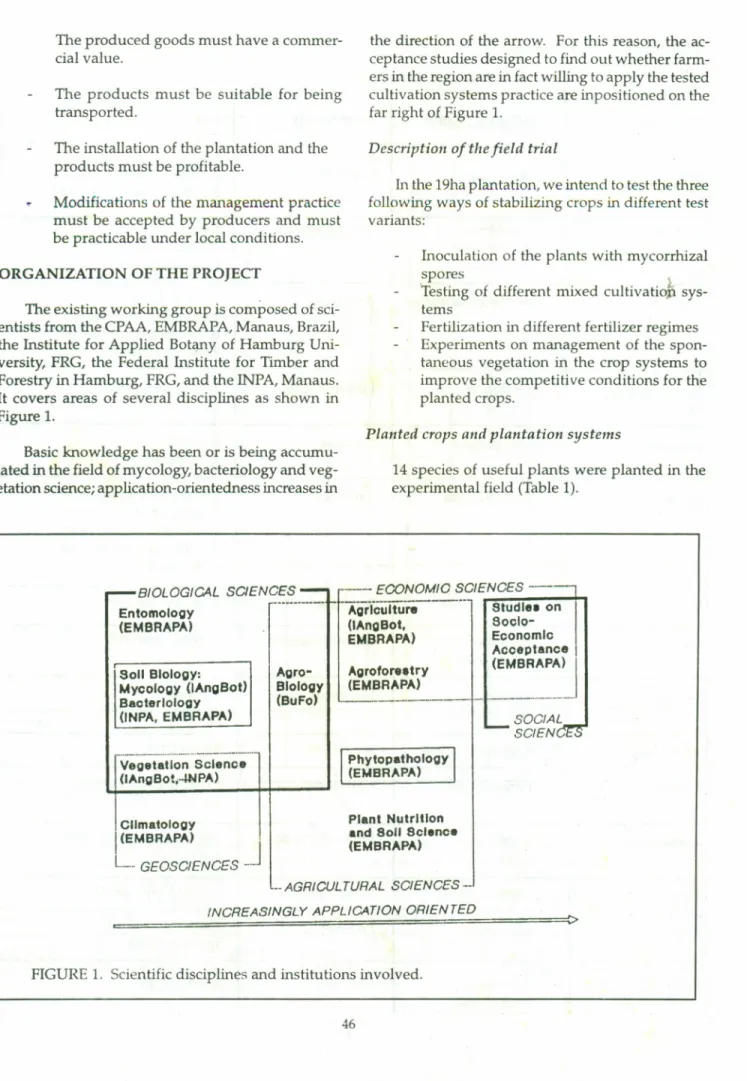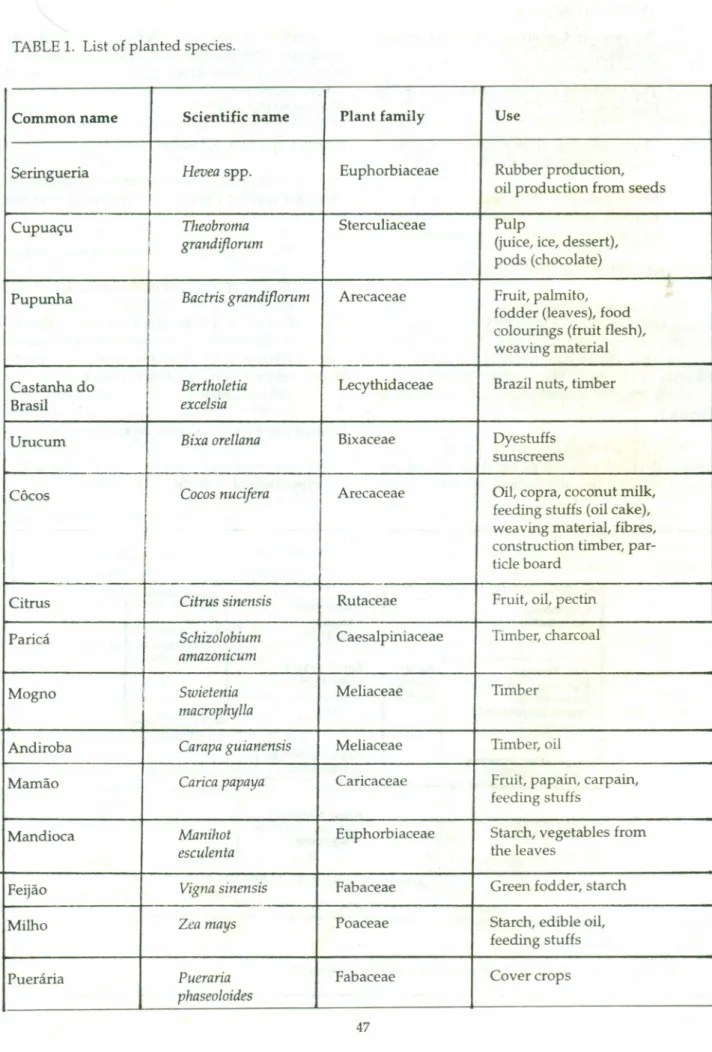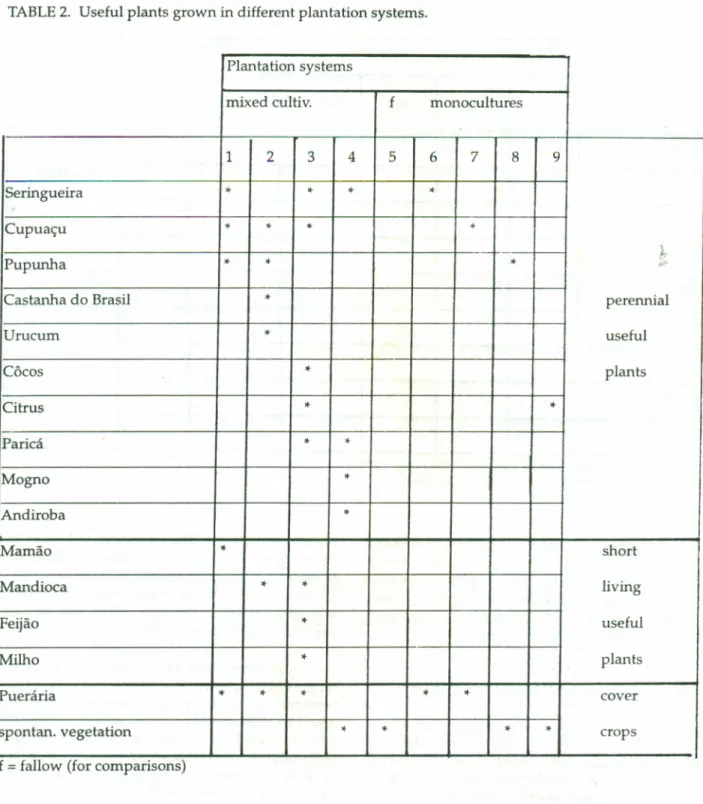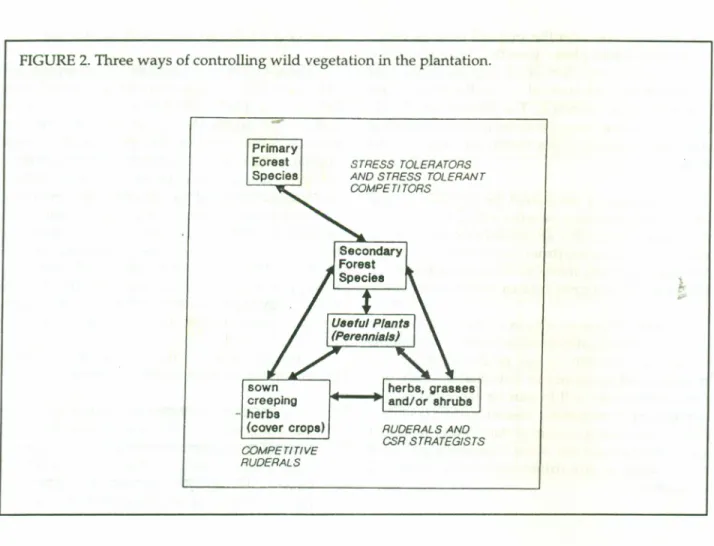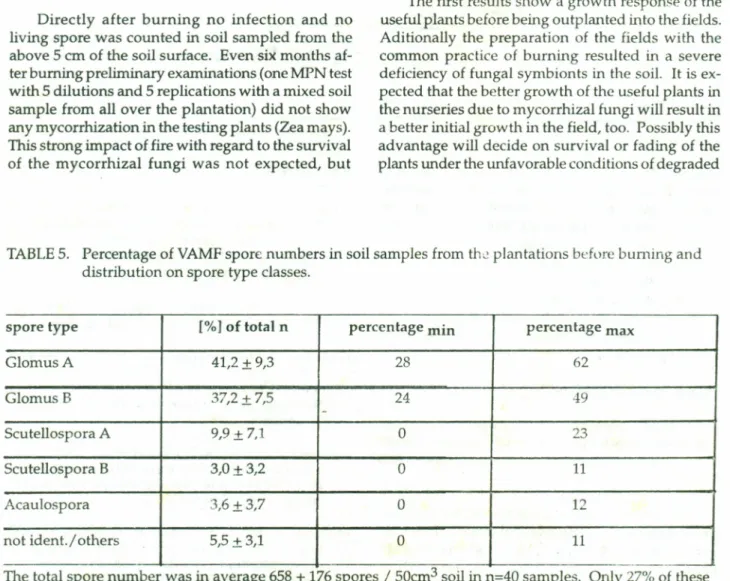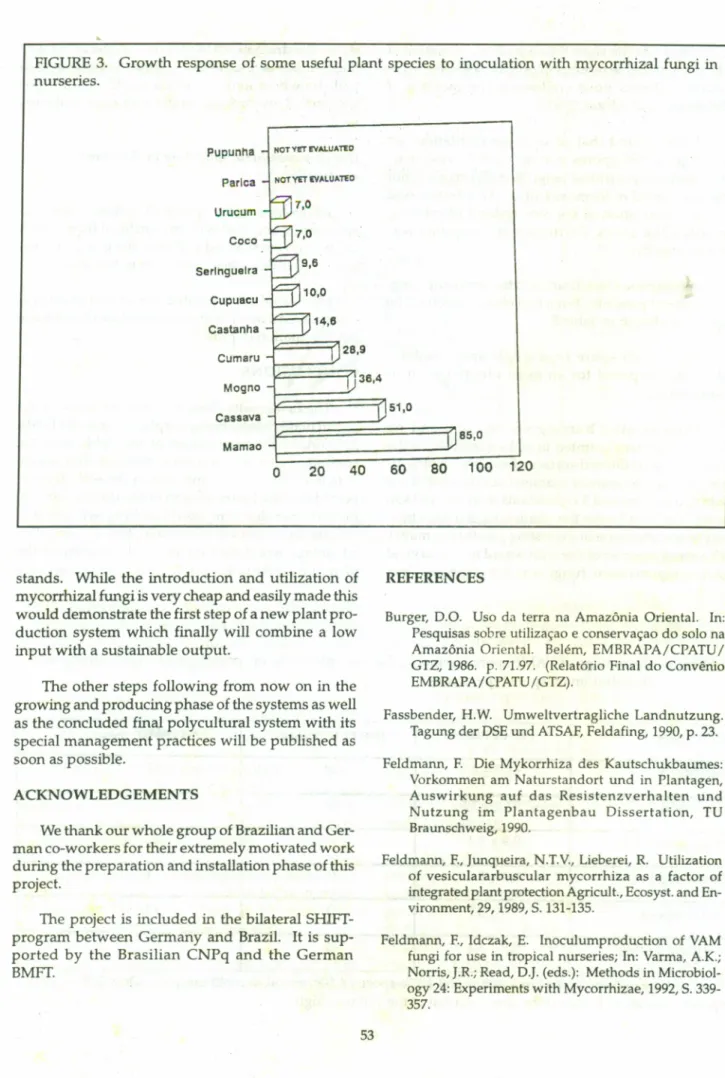~ A
zyxwvutsrqponmlkjihgfedcbaZYXWVUTSRQPONMLKJIHGFEDCBA~~~o
l/óolQÇ
MANAGEMENT AND REHABILITATION OF
DEGRADED LANDS AND SECONDARY FORESTS
.IN AMAZONIA:
'--{
E M B R ~ P A - C P A A B ib lio t e c a
An International Symposium/Workshop
April18-22, 1993 Hotel Tropical Santarém, Pará - Brazil
Organized by:
Intemational Institute of Tropical Forestry USDA - Forest Service
Southem Forest Experiment Station Rio Piedras, Puerto Rico, USA
EMBRAPA/CPATU
Centro de Pesquisa Agroflorestal da Amazônia Oriental Belém, Pará, Brasil
In Collaboration with:
Instituto Brasileiro do Meio Ambiente e dos Recursos Naturais Renováveis - IBAMA
Santarém, Pará, Brasil
With Support from:
Tropical Forestry Program Intemational Forestry
U.S. Department of Agriculture - Forest Service Washington, DC, USA
and
~:a.
Man and the Biosphere Prograrnrne (MAB)UTILIZATION
OF ABANDONED
AREAS IN AMAZONIA
BY POLYCULTURES
OF PERENNIAL USEFUL PLANTS
F. Feldmannl, L. Gasparottoé, R. Liebereil,H. PreisingerlVUTSRQPONMLKJIHGFEDCBA
l I n s t i t u t f ü r A n g e w a n d t e B o t a n i k
H a m b u r g , F e d e r a l R e p u b l i c o f G e r m a n y
2 C P A A / E M B R A P AA Ivum aus, A M , B r a s i lUTSRQPONMLKJIHGFEDCBA
A B S T R A C T
Degraded fallow areas of primarily monocultural plantations will be transferred into a locally-adapte form of utilization through special consideration of soil microbiological factors (funga I and bacterial sym-bionts). In accordance with the heterogeneity of natural plant communities, polycultures of several perennial and annual ecologically adapted useful plants are installed. During the installation phase mycorrhizal fungi are introduced as important biological factors to optimize the ecological fitness of the plant material. After the implantation of the polyculture the spontaneous secondary vegetation is managed carefully to reach a jointly beneficial growth of the secondary vegetation with the useful plants. In this type of naturally enriched polyculture special regard is paid to a careful use of pesticides and fertilizers in order to come to a plant production system with low input and sustaining medium output. Low input systems with a mixture of annual and perennial plants result in an ecologically and economically equilibrated situation for small scale producers. In this contribution the organization of a multidisciplinary project between Brazilian and German institutions is demonstrated as well as the results of the installation phase of the project.
INTRODUCTION
Although numerous attempts exist to recultivate degraded sites of formerly utilized areas in Amazonia, the success of reaching to a sustainable land-use is relatively small.
The handling of short nutrient cycles, leaching of nutrients on one hand, bad availability of nutri-ents on the other hand, the importance of the het-erogcneity of the natural plant cover, and the inter-actions between flora, fauna, and microorganisms are so far not well analysed and understood. The few data yet available must be supplemented and put into practice rapidly to allow the prompt deve1
-opment of concepts for effective protection of the rainforest and simultaneous ensurance of the social and economic development of the region.
A resolution for the agricultura I probIems of Amazonia probabIy can be found in a mixed culti-vation of selected, perennial plants adapted to the special environmental conditions of the region and combined with annual and biannual crops. The polyculture system may help to create conditions
which are similar to those existing in the primary plant cover. The function of perennial trees as reservoires for nutrients and their role in the recy-cling of biomass in complex systems was demon-strated (e.g. Shubarth 1977;Sioli 1980; Burger 1986). Especially in Amazonia a consequent transfer of these findings to practice is still in its beginnings.
Several studies indicate, that principally a recultivation of abandoned areas is possible. The main problems lie in the fact that a recultivation has to be sustainable for a very long time period and therefor has necessarily to be profitable for small scale producers. That means that methods have to be developed which lower the input into a produc-tion system especially during the critical installaproduc-tion phase - and ensures an output which meliorates the life standard of the producers without loosing the productivityA of the fields already after a short time.
In the attempt reported here different factors are taken into account which are stabilizing biological controlling systemsVUTSRQPONMLKJIHGFEDCBA( e . g . for nutrient cycling or epedimiology of diseases). The management prac-tices include treatments for the improvement of bio-logical factors of soils (Feldmann e t a I . 1 9 8 9 ;
Feldmann and Idczak 1992; Feldmann e t a l . 1993a),
e . g . the introduction of symbionts and the utiliza-tion of plants which are mycotroph and living in symbiosis with N-fixing bacteria (Feldmann e t a l .
1993b); beneath that a high number of plant species together with the useful plants is allowed to grow, and the use of pesticides is minimized.
In cooperation with the three large institutions in Manaus: CPAA, INPA and UNAMAZ/UA the following items will be carried out:
Former plantation areas of the CPAA are recultivated with polyculture systemsof dif-ferent useful plants.
Symbiontic fungi are multiplied and inocu-lum is prepared using locally adapted meth-ods.
In the initial phase of the project selected symbionts are used to optimize the plants' establishing phase, health and growth. Recultivation is accompanied by studies on the ecological and economical effect of natu-ral secondary vegetation growing sponta-neously in the polycultural system.
a management concept for the transfer of the results into the common practice will be deduced from the results.
THEORETICAL BASIS FOR THE PROJECT
Prior results demonstrated the importance es-pecially of soil-microbiological factors, the adaptedness of the utilized plants and the heteroge-neity of the vegetation for the stability of agroecosystems. These parameters are the basis for a successful recultivation of lying fallow and degraded areas and their long-term use.
The plant production system demonstrated here therefore fulfills the following items:
- An adapted agroecosystem in the Amazon basin has to be a polyculture with the use of mainly perennial, indigenous trees.
Degraded areas have only very few essen-tial, symbiontic organisms (see Feldmann e t
a i .elsewhere in this volume). In the initial phase of a recultivation effective symbionts, especially mycorrhizal fungi, have to be in-troduced to the plant production system. A high soil-microbiological stability and high diversity of effective, adapted soil mi-croorganisms is supported by a high num-ber of different host-species. That means that the inclusion of the natural secondary vegetation should have high importance for the stabilization of populations of soil-mi-croorganisms and therefore for the intro-duced hosts, the useful plants, too.
The management of the plantation has to be carried out in a way that a high diversity of soil-microorganisms remains in the soil. That means a low input of pesticides and a controlled amount of fertilizers (normally much less than without rnycorrhization of the plants) is recommended.
A high diversity of useful plants/natural vegetation probably will enhance the dis-ease tolerance of the whole system by chang-ing the microclimate and giving the possi-bility to establish natural controlling sys-tems, as long as the secondary vegetation does not contain host plants for pathogens or pests, which attack the crops.
The selected useful plants have to be
The produced goods must have a commer-cial value.
The products must be suitable for being transported.
The installation of the plantation and the products must be profitable.
.,. Modificatians of the management practice
must be acceptedUTSRQPONMLKJIHGFEDCBAb y producers and must be practicable under local conditions.
ORGANIZATlON OF THE PROJECT
The existing warking group is composed of sei-entists from the CPAA, EMBRAPA,Manaus, Brazil, the Institute for Applied Botany of Hamburg Uni-versity, FRG, the Federal Institute for Timber and Forestry in Hamburg, FRG, and the INPA, Manaus. It covers areas of several disciplines as shown in Figure 1.
Basic knowledge has been or is being accumu-lated in the field of mycology, bacteriology and veg-etation science; application-orientedness increases in
the direction of the arrow. For this reason, the ac-ceptance studies designed to find out whether farm-ers in the region are in fact willing to apply the tested cultivation systems practice are inpositioned on the far right of Figure 1.VUTSRQPONMLKJIHGFEDCBA
D e s c r i p t i o n o f t h e f i e l d t r i a l
In the 19ha plantation, we intend to test the three follawing ways of stabilizing crops in different test variants:
Inoculation of the plants with mycorrhizal
.spores }.
Testing of different mixed cultivatiop sys-tems
Fertilization in different fertilizer regimes Experiments on management of the spon-taneous vegetation in the crop systems to improve the competitive conditions for the planted crops.
P l a n t e d c r o p s a n d p l a n t a t i o n s y s t e m s
14 species of useful plants were planted in the experimental field (Table 1).A
A G R IC U LTU R A L S C IE N C E S
--IN C R E A S --IN G LY A P P LlC A T/O N O R IE N TE D
======~~~~~====================~~
FIGURE 1. Scientific disciplines and institutions involved.
r--B IO LO G IC A L S C IE N C E S
---_GFEDCBA.._----..
-E n t o m o l o g y ( E M B A A P A )
A g r o · B l o l o g y ( B u F o )
-.---- E C O N O M IC S C IE N C E S - - - l
A g r T c u l t u n t - - - - S t u d l u o n
I
( l A n g B o t , s c c lo-E M B A A P A ) E c o n o m l c A c e e p t a n e e I
t : ~ ~ ~ ~ ~ ~ ~
_ _. . .
_.. .
::~_::~~~_..1
~S O C IA .~ S C IE N l/cv
5 0 1 1 B l o l o g y : M y e o l o g y ( l A n g S o t ) B a e t e r l o l o g y ( l N P A , E M B R A P A )
V e g e t a t l o n S e l e n e . ( l A n g B o t ; - 4 N P A )
C l l m a t o l o g y
I
( E M B R A P A )J
1.... -.- G E O S C IE N C E S
-.,-P h y t o p a t h o l o g y
I
( E t . l B R A P A )TABLE 1. List of planted species.
Commonname Scientific name Plant family Use
SeringueriaVUTSRQPONMLKJIHGFEDCBAH e v e a spp. Euphorbiaceae Rubber production, oil production from seeds
Cupuaçu T h e o b r o m a Sterculiaceae PulpUTSRQPONMLKJIHGFEDCBA
I
g r a n d i f l o r u m pods (chocolate)(juice, ice, dessert),Pupunha B a c t r i s g r a n d i f l o r u m Arecaceae Fruit, palmito,
t
fodder (leaves), food colourings (fruit flesh), weaving material
Castanha do B e r t h o l e t i a Lecythidaceae Brazil nuts, timber
Brasil e x c e l s i a
Urucum B i x a o r e l l a n a Bixaceae Dyestuffs
sunscreens
-Côcos C o c o s n u c i f e r a Arecaceae Oil, copra, coconut milk,
feeding stuffs (oil cake), weaving material, fibres,
I
construction timber, par-ticle board.._ - -
~---Citrus C i t r u s s i n e n s i s Rutaceae Fruit, oil, pectin
Paricá S c h i z o l o b i u m Caesalpiniaceae Timber, charcoal a m a z o n i c u m
Mogno S w i e t e n i a Meliaceae Timber
\
m a c r o p h y l l a
Andiroba C a r a p a g u i a n e n s i s Meliaceae Timber,oil
Mamão C a r i c a p a p a y a Caricaceae Fruit, papain, carpain,
feeding stuffs
Mandioca M a n i h o t Euphorbiaceae Starch, vegetables from
e s c u l e n i a the leaves
Feijão V i g n a s i n e n s i s Fabaceae Green fodder, starch
Milho Z e a m a y s Poaceae Starch, edible oil,
feeding stuffs
Puerária P u e r a r i a Fabaceae Cover crops p h a s e o l o i d e s
TABLE 2. Useful plants grown in different plantation systems.
Plantation systems
mixed cultivo f monocultures
1UTSRQPONMLKJIHGFEDCBA2 3 4 5 6 7 8 9
Seringueira
..
..
..
..
..
Cupuaçu
..
..
..
..
f.
Pupunha
..
..
..
.,..,Castanha do Brasil
..
perennialUrucum
..
use fuICôcos
..
plantsCitrus
..
..
Paricá
..
..
Mogno
..
Andiroba
..
Mamão
..
shortMandioca
..
..
livingFeijão
..
use fuiMilho
..
plantsPuerária
..
..
..
..
..
coverspontan. vegetation
..
..
..
..
cropsf= fallow (for comparisons)
Four different mixed cultivation systems
(sys-tems 1-4, see Table 2) and four conventional
monoc-ultures (systems 6-9) are to be compared in the field
trial. System 5 is land which was prepared in the
same way as the other systems and then left to its
own devices. Perennials, short-term crops for
plant-ing between the rows and cover plants are being
used in the systems. The choice of crops was based
largely on current marketing prospects.
System 1 is a comparatively intensive
cultiva-tion system with little space left between the rows,
More space was left between rows in systems 2 and
3, which can be used for growing short-term crops
in the first year. In practice, this would help
farm-ers survive the first years after establishment of the
plantation, during which the Ionger-Iived species are
not generating any income. System 4 is the most
TABLE3. Plantation systems and test variants applied.
n=54 Ofertilizer 30% fertiL 100% fertil.
-
UTSRQPONMLKJIHGFEDCBA+-
+ - +myc. myc. myc. myc. myc. myc.
system 1 * * * * mixed
system 2 * * * * cultivation
system 3 * * * *
system4 *
system 5 •• fallow
system 6 *
system 7 * monoculture
system 8 ••
system 9 *
- myc. = not inoculated with mycorrhizal fungi spores
+ myc. = inoculated with mycorrhizal spores
produce timber. Secondary vegetation is tolerated between the trees. In systems 1-3 and in monocul-tures 6-8, on the other hand, cover plants have been sown (Pueraria phaseoloides). For the later transfer to practice probably not only one but an appropri-ate combination of different systems will be recom-mended.VUTSRQPONMLKJIHGFEDCBA
P l a n t a t i o n s y s t e m s a n d l a y o u t o n t h e f i e l d s
The nine plantation systems described are be-ing established in different test variants (Table 3). Some of the young plants have been inoculated with mycorrhiza, the remainder have not. The fertiliza-tion variants include zero fertilizer, 30% and 100% of the recommended dose for the respective species.
That gives a total of n=54 possible variants. In our experiment we implemented the 18 variants which promise to give the most meaningful com-parisons.
In the field test the 18 variants are being laid out as blocks, with five complete blocks and repeats. The position of the variants within the blocks is
com-pletely randomized. The plots have an area of 48 x 32 m2 each. The layout of the plots is determined by the elongated, irregular shape of the experimen-'tal area. A 100 x 100 m2 patch of secondary forest
was left standing at the edge of the area for com-parative studies of the secondary vegetation.
The experimental area concems terra firme lands on the EMBRAPAsite, Km 28, Am 010. These areas were first cleared of primary forest about ten years ago, then used as rubber tree monocultures and last left unattended. In August 1992, the approximately eight-year-old secondary forest was cleared and bumt in the traditional manner. Since April 1993 the plantation is established.
FIRST RESULTS OF THE PROJECT'S INSTALLATION PHASE
S p o n t a n e o u s v e g e t a t i o n f o u r m o n t h s a f t e r
c l e a r i n g
af---
--.
r.-ter clearing - and afr.-ter the area had been surveyed and divided into plots - growth form types of the spontaneous vegetation of all 90 plots of the trial were assessed quantitatively,VUTSRQPONMLKJIHGFEDCBAi . e . on the basis of their respective area coverage. The pattems are the re-sult of the former use of the sites and of pedological differences between sites within the experimental a ea.
A preliminary analysis of the data reveals het-ero~enous vegetation pattems within the plots (on a m scale), but clearly distinguishable pattems in a north-south direction (from blockA to block E). The following growth forms show dominance in the blocks of the experimental area as shown in Table 4.
A more detailed analysis of the data is yet to come. So far the pattems are interpreted as pattems of different intensity of use, or also differences in intensity and frequency of disturbance. Although
these differences will in part be cancelled outUTSRQPONMLKJIHGFEDCBAb y
subsequent management measures, the vegetation differences observed are important as they represent the starting conditions of the experiment and must be included as site differences in the final trial evaluation.
C o n t r o l o f w í l d v e g e t a t i o n i n t h e p l a n t a t i o n
The spontaneous vegetation which regenerates or colonizes the space between the plantation crops can, on one hand, constitute competition for the crops (light, nutrients, space) and must be sup-pressed in this case. On the other hand, the wild vegetation can be an important store of nutrients, which become available to the crops after dieback and mineralization of the biomass. As well a high diversity of the secondary vegetation probably will mean an equiJibration of ecological controlling sys-tems,e .g .occurrcnce of diverse communities of sym-bionts or other beneficia! microbes. Whethe these two opposed processes can be optimized in favor of the cropsb y appropriate control of the wild vegeta-tion, is a question which has to be examined.
Basically there are thrce ways of controlling growth of wild vegetation (Figure 2):
the secondary vegetation is allowed to regener-ate, but is occasionally cleared from the space immediately around the crop plants. In this case mainly trees,i . e . long-lived growth forms, would benefit. The species spectrum would be com-pressed due to the occasional disturbance.
TABLE4. Growth form structure of the spontaneous vegetation in thc different blocks 4 months after clearing.
Growth forms dorninant in block(s):
Trees A,B
Shrubs nowhere dominant
Herbs Tussock grasses B, D, E
Stolon grasses nowhere dominant
upright growing dic. herbs D
creeping, dicotyl. herbs C,D
Fems (bracken) E
S TR E S S TO LE R A TO R S A N O S TR E S S TO LE R A N T
C O M P E TI TO R SzyxwvutsrqponmlkjihgfedcbaZYXWVUTSRQPONMLKJIHGFEDCBA FIGURE 2. Three ways of controlling wild vegetation in the plantation.
the cultivation area is kept free of taller growth forms,VUTSRQPONMLKJIHGFEDCBAi . e . the regeneration of secondary forest species is frequently disturbed. In this case the long-lived herbs and grasses would benefit.
herb species with creeping growth forms are sown,e .g . Pueraria. This would lead to a dense undergrowth of one or a very few species. The three different ways of treating the under-growth each favor different ecomorphological plant types according to Grirne (1979, 1988): - sowing favours fast-growing types with a high nutrient requirement (competitive ruderals).
frequent cutting and hoeing favours short-lived herbaceous species and species which can regen-erate quickly from the buds at the soil surface (ruderals and CSR strategy types),
minimum management favors regeneration of part of the species spectrum of the secondary forest.
R U O E R A LS A N O
C S R S TR A TE G IS TSUTSRQPONMLKJIHGFEDCBA
P r im a r y F o r e s t S p e c ie s
s o w n c r e e p in g - h e r b s
( c o v a r c r o p e )
C O M P E T/T/V E R U O E R A LS
The arrows indicate different competitive situ-ations due to the management of the planting sys-tems. CSR strategists according to Grime (1979, 1988).
In the field experiment cover plants have been sown (see above) in some of the test variants, be-cause of the positive experience on the farming site that exists with this method; in other variants secondary vegetation will be tested as cover plants.
O c c u r r e n c e o f m y c o r r h i z a l f u n g u s s p o r e s b e f o r e a n d a f t e r b u r n i n g
The highly important symbionts of most of the useful plants in tropical regions are severly influ-enced by the management practices in Arnazonian plantations (Feldmann and Lieberei 1992). To esti-mate the influence ofburning before the plantations' establishment, 40 soil samples were surveyed to count the number of spores and to classify the oc-curring spore types before burning. Irnrnediately
---~---=~.-,~
---
zyxwvutsrqponmlkjihgfedcbaZYXWVUTSRQPONMLKJIHGFEDCBAevaluated. At the same time a further estimation of
the most probable number of propagules in the plan-tation soil was done (following the method of Feldmann and Idczak 1992).
It was found that all over the plantations an
average of 658 spores per cm soil of
vesicular-arbuscular mycorrhizal fungi (VAMF) occurred, but only one third of them was alive. An infection and rapid colonization of the root systems of catching plants (Zea mays, Petroselinum crispum) was
easily possible.
A complete identification of the occurring fungi was not yet possible. But a first classification of the spores is shown in Table 5.
From each spore type single spore isolates are now prepared for an exact identification or description.
Directly after burning no infection and no living spore was counted in soil sampled from the above 5 em of the soil surface. Even síx months af-ter buming preliminary examinations (one MPN test with 5 dilutions and 5 replications with a mixed soil sample from al1 over the plantation) did not show any mycorrhization in the testing plants (Zea mays). This strong impact of fire with regard to the survival of the mycorrhizal fungi was not expected, but
shows the dramatic changes which come along with the buming of the fields. Further periodical tests will show how long it will take until the infection potential of mycorrhizal fungi arises again in the test fields.VUTSRQPONMLKJIHGFEDCBA
I l s e o f m y c o r r h i z a l i n o c u l u m i n t h e p l a n t p r o d u c t i o n
As described above plants of the half of test vari-ants were inoculated with mycorrhizal fungi. How the fungi were selected and how the inoculum was produced is descr ibed elsewhere in this volume.
Up to row, ali evaluated inoculated plant }pe-cies showed a much better growth than plants with-out inoculation (Figure 3).
CONCLUSIONS
The first results show a growth response of the useful plants before being outplanted into the fields. Aditionally the preparation of the fields with the common practice of buming resulted in a severe deficiency of fungal symbionts in the soil, It is ex-pected that the better growth of the useful plants in the nurseries due to mycorrhizal fungi will result in a better initial growth in the field, too. Possibly this advantage will decide on survival or fading of the plants under the unfavorable conditions of degraded
TABLE 5. Percentage of VAMF spore numbers in soil samples from thc plantations before buming and distribution on spore type classes.
spore type [%J of total n percentage min percentage max
GlomusA 41,2 ± 9,3 28 62
Glomus B 37,2 ± 7,5 24 · 19
-Scutellospora A 9,9 ± 7,1UTSRQPONMLKJIHGFEDCBAO 23
Scutellospora B 3,0 ±3,2 O 11
Acaulospora 3,6 ±3,7 O 12
not ident./others 5,5 ±3,1 O 11
FIGURE 3. Growth response of some useful plant species to inoculation with mycorrhizal fungi in nurseries.UTSRQPONMLKJIHGFEDCBA
H O T V E TE V A l.U A ~ D
P u p u n h a
H O T Y E T E V " 'L U A ~ D
P a r lc a U r u c u m C o c o S e r in g u e ir a
C u p u a c u C a s ta n h a C u m a r u M o g n o C a s s a v a M a m a o
80 100 120
60
40
20
o
stands. While the introduction and utilization of mycorrhizal fungi is very cheap and easily made this would demonstrate the first step of a new plant pro-duction system which finally will combine a low input with a sustainable output.
REFERENCES
Burger, D.O. Uso da terra na Amazônia Oriental. In: Pesquisas sobre utilizaçao e conservaçao do solo na Amazônia Oriental. Belérn, EMBRAPA/CPATU/ GTZ, 1986. p. 71.97. (Relatório Final do Convênio EMBRAPA/CPATU /GTZ).
The other steps following from now on in the growing and producing phase of the systems as well as the concluded final polycultural system with its special management practices will be published as soon as possible.
Fassbender, H.W. Umweltvertragliche Landnutzung. Tagung der DSE und ATSAF, Feldafing, 1990, p. 23. Feldmann, F. Die Mykorrhiza des Kautschukbaumes:
Vorkommen am Naturstandort und in Plantagen, Auswirkung auf das Resistenzverhalten und Nutzung im Plantagenbau Dissertation, TU Braunschweig,1990.
ACKNOWLEDGEMENTS
We thank our whole group of Brazilian and Ger-man co-workers for their extremely motivated work during the preparation and installation phase of this project.
Feldmann, F.,[unqueira, N.T.V.,Lieberei, R. Utilization of vesiculararbuscular mycorrhiza as a faetor of integrated plantprotectionAgricult., Ecosyst. and En-vironment,29, 1989, S. 131-135.
The project is included in the bilateral SHIFT-program between Germany and Brazil. It is sup-ported by the Brasilian CNPq and the German BMFT.
Feldmann, F., Idczak, E. Inoculumproduetion of VAM fungi for use in tropical nurseries; In: Varrna, A.K.; Norris, ].R.; Read, D.]. (eds.): Methods in Microbiol-ogy 24: Experiments with Mycorrhizae, 1992, S. 339-357.
